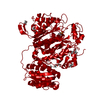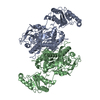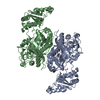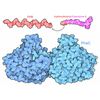[English] 日本語
 Yorodumi
Yorodumi- PDB-7zmf: Dehydratase domain of module 3 from Brevibacillus Brevis orphan BGC11 -
+ Open data
Open data
- Basic information
Basic information
| Entry | Database: PDB / ID: 7zmf | ||||||
|---|---|---|---|---|---|---|---|
| Title | Dehydratase domain of module 3 from Brevibacillus Brevis orphan BGC11 | ||||||
 Components Components | Putative polyketide synthase | ||||||
 Keywords Keywords | BIOSYNTHETIC PROTEIN / Dehydratase / polyketide synthase / Double hot dog fold | ||||||
| Function / homology |  Function and homology information Function and homology informationDIM/DIP cell wall layer assembly / fatty acid synthase activity / phosphopantetheine binding / 3-oxoacyl-[acyl-carrier-protein] synthase activity / fatty acid biosynthetic process / metal ion binding / plasma membrane / cytoplasm Similarity search - Function | ||||||
| Biological species |  Brevibacillus brevis NBRC 100599 (bacteria) Brevibacillus brevis NBRC 100599 (bacteria) | ||||||
| Method |  X-RAY DIFFRACTION / X-RAY DIFFRACTION /  SYNCHROTRON / SYNCHROTRON /  MOLECULAR REPLACEMENT / MOLECULAR REPLACEMENT /  molecular replacement / Resolution: 2.21 Å molecular replacement / Resolution: 2.21 Å | ||||||
 Authors Authors | Tittes, Y.U. / Herbst, D.A. / Jakob, R.P. / Maier, T. | ||||||
| Funding support |  Switzerland, 1items Switzerland, 1items
| ||||||
 Citation Citation |  Journal: Sci Adv / Year: 2022 Journal: Sci Adv / Year: 2022Title: The structure of a polyketide synthase bimodule core. Authors: Yves U Tittes / Dominik A Herbst / Solène F X Martin / Hugo Munoz-Hernandez / Roman P Jakob / Timm Maier /  Abstract: Polyketide synthases (PKSs) are predominantly microbial biosynthetic enzymes. They assemble highly potent bioactive natural products from simple carboxylic acid precursors. The most versatile ...Polyketide synthases (PKSs) are predominantly microbial biosynthetic enzymes. They assemble highly potent bioactive natural products from simple carboxylic acid precursors. The most versatile families of PKSs are organized as assembly lines of functional modules. Each module performs one round of precursor extension and optional modification, followed by directed transfer of the intermediate to the next module. While enzymatic domains and even modules of PKSs are well understood, the higher-order modular architecture of PKS assembly lines remains elusive. Here, we visualize a PKS bimodule core using cryo-electron microscopy and resolve a two-dimensional meshwork of the bimodule core formed by homotypic interactions between modules. The sheet-like organization provides the framework for efficient substrate transfer and for sequestration of trans-acting enzymes required for polyketide production. | ||||||
| History |
|
- Structure visualization
Structure visualization
| Structure viewer | Molecule:  Molmil Molmil Jmol/JSmol Jmol/JSmol |
|---|
- Downloads & links
Downloads & links
- Download
Download
| PDBx/mmCIF format |  7zmf.cif.gz 7zmf.cif.gz | 388.8 KB | Display |  PDBx/mmCIF format PDBx/mmCIF format |
|---|---|---|---|---|
| PDB format |  pdb7zmf.ent.gz pdb7zmf.ent.gz | 266.9 KB | Display |  PDB format PDB format |
| PDBx/mmJSON format |  7zmf.json.gz 7zmf.json.gz | Tree view |  PDBx/mmJSON format PDBx/mmJSON format | |
| Others |  Other downloads Other downloads |
-Validation report
| Summary document |  7zmf_validation.pdf.gz 7zmf_validation.pdf.gz | 448.2 KB | Display |  wwPDB validaton report wwPDB validaton report |
|---|---|---|---|---|
| Full document |  7zmf_full_validation.pdf.gz 7zmf_full_validation.pdf.gz | 453.4 KB | Display | |
| Data in XML |  7zmf_validation.xml.gz 7zmf_validation.xml.gz | 21 KB | Display | |
| Data in CIF |  7zmf_validation.cif.gz 7zmf_validation.cif.gz | 28.7 KB | Display | |
| Arichive directory |  https://data.pdbj.org/pub/pdb/validation_reports/zm/7zmf https://data.pdbj.org/pub/pdb/validation_reports/zm/7zmf ftp://data.pdbj.org/pub/pdb/validation_reports/zm/7zmf ftp://data.pdbj.org/pub/pdb/validation_reports/zm/7zmf | HTTPS FTP |
-Related structure data
| Related structure data |  7zm9C  7zmaC  7zmcC  7zmdC  7zskC  5hqwS S: Starting model for refinement C: citing same article ( |
|---|---|
| Similar structure data | Similarity search - Function & homology  F&H Search F&H Search |
- Links
Links
- Assembly
Assembly
| Deposited unit | 
| ||||||||||||||||||||||||||||||||||||||||||||||||||||||||||
|---|---|---|---|---|---|---|---|---|---|---|---|---|---|---|---|---|---|---|---|---|---|---|---|---|---|---|---|---|---|---|---|---|---|---|---|---|---|---|---|---|---|---|---|---|---|---|---|---|---|---|---|---|---|---|---|---|---|---|---|
| 1 |
| ||||||||||||||||||||||||||||||||||||||||||||||||||||||||||
| Unit cell |
| ||||||||||||||||||||||||||||||||||||||||||||||||||||||||||
| Components on special symmetry positions |
| ||||||||||||||||||||||||||||||||||||||||||||||||||||||||||
| Noncrystallographic symmetry (NCS) | NCS domain:
NCS domain segments:
|
- Components
Components
| #1: Protein | Mass: 33427.824 Da / Num. of mol.: 2 Source method: isolated from a genetically manipulated source Source: (gene. exp.)  Brevibacillus brevis NBRC 100599 (bacteria) Brevibacillus brevis NBRC 100599 (bacteria)Gene: BBR47_39880 / Production host:  #2: Chemical | #3: Chemical | ChemComp-GOL / | #4: Water | ChemComp-HOH / | Has ligand of interest | N | |
|---|
-Experimental details
-Experiment
| Experiment | Method:  X-RAY DIFFRACTION / Number of used crystals: 1 X-RAY DIFFRACTION / Number of used crystals: 1 |
|---|
- Sample preparation
Sample preparation
| Crystal | Density Matthews: 2.09 Å3/Da / Density % sol: 41.25 % |
|---|---|
| Crystal grow | Temperature: 293 K / Method: vapor diffusion, sitting drop Details: 0.2 ul drops of 3.9 mg ml-1 protein in buffer( 20 mM Hepes KOH pH 8.0, 250 mM NaCl, 5 % v/v glycerol, 5 mM DTT) with 0.2 ul of reservoir solution (20 % w/v PEG 500 MME; 10% PEG 20000, 0.1 M ...Details: 0.2 ul drops of 3.9 mg ml-1 protein in buffer( 20 mM Hepes KOH pH 8.0, 250 mM NaCl, 5 % v/v glycerol, 5 mM DTT) with 0.2 ul of reservoir solution (20 % w/v PEG 500 MME; 10% PEG 20000, 0.1 M Tris;BICINE pH 8.5, 0.06 M MgCl hexahydrate, 0.06 M CaCl dihydrate) |
-Data collection
| Diffraction | Mean temperature: 100 K / Serial crystal experiment: N |
|---|---|
| Diffraction source | Source:  SYNCHROTRON / Site: SYNCHROTRON / Site:  SLS SLS  / Beamline: X06SA / Wavelength: 1 Å / Beamline: X06SA / Wavelength: 1 Å |
| Detector | Type: DECTRIS EIGER X 16M / Detector: PIXEL / Date: May 18, 2018 |
| Radiation | Protocol: SINGLE WAVELENGTH / Monochromatic (M) / Laue (L): M / Scattering type: x-ray |
| Radiation wavelength | Wavelength: 1 Å / Relative weight: 1 |
| Reflection | Resolution: 2.21→48.68 Å / Num. obs: 28971 / % possible obs: 99.02 % / Redundancy: 13.39 % / Biso Wilson estimate: 44.38 Å2 / CC1/2: 0.999 / Rsym value: 0.1468 / Net I/σ(I): 14.42 |
| Reflection shell | Resolution: 2.21→2.26 Å / Num. unique obs: 2086 / CC1/2: 0.67 |
-Phasing
| Phasing | Method:  molecular replacement molecular replacement |
|---|
- Processing
Processing
| Software |
| |||||||||||||||||||||||||||||||||||||||||||||||||||||||||||||||||||||||||||||||||||||||||||||||||||||||||
|---|---|---|---|---|---|---|---|---|---|---|---|---|---|---|---|---|---|---|---|---|---|---|---|---|---|---|---|---|---|---|---|---|---|---|---|---|---|---|---|---|---|---|---|---|---|---|---|---|---|---|---|---|---|---|---|---|---|---|---|---|---|---|---|---|---|---|---|---|---|---|---|---|---|---|---|---|---|---|---|---|---|---|---|---|---|---|---|---|---|---|---|---|---|---|---|---|---|---|---|---|---|---|---|---|---|---|
| Refinement | Method to determine structure:  MOLECULAR REPLACEMENT MOLECULAR REPLACEMENTStarting model: 5hqw Resolution: 2.21→48.68 Å / SU ML: 0.304 / Cross valid method: FREE R-VALUE / σ(F): 1.35 / Phase error: 27.7809 Stereochemistry target values: GeoStd + Monomer Library + CDL v1.2
| |||||||||||||||||||||||||||||||||||||||||||||||||||||||||||||||||||||||||||||||||||||||||||||||||||||||||
| Solvent computation | Shrinkage radii: 0.9 Å / VDW probe radii: 1.11 Å / Solvent model: FLAT BULK SOLVENT MODEL | |||||||||||||||||||||||||||||||||||||||||||||||||||||||||||||||||||||||||||||||||||||||||||||||||||||||||
| Displacement parameters | Biso mean: 58.84 Å2 | |||||||||||||||||||||||||||||||||||||||||||||||||||||||||||||||||||||||||||||||||||||||||||||||||||||||||
| Refinement step | Cycle: LAST / Resolution: 2.21→48.68 Å
| |||||||||||||||||||||||||||||||||||||||||||||||||||||||||||||||||||||||||||||||||||||||||||||||||||||||||
| Refine LS restraints |
| |||||||||||||||||||||||||||||||||||||||||||||||||||||||||||||||||||||||||||||||||||||||||||||||||||||||||
| Refine LS restraints NCS | Type: Torsion NCS / Rms dev position: 1.63740857784 Å | |||||||||||||||||||||||||||||||||||||||||||||||||||||||||||||||||||||||||||||||||||||||||||||||||||||||||
| LS refinement shell |
| |||||||||||||||||||||||||||||||||||||||||||||||||||||||||||||||||||||||||||||||||||||||||||||||||||||||||
| Refinement TLS params. | Method: refined / Origin x: 15.8394365294 Å / Origin y: 22.8248612221 Å / Origin z: 0.101442614505 Å
| |||||||||||||||||||||||||||||||||||||||||||||||||||||||||||||||||||||||||||||||||||||||||||||||||||||||||
| Refinement TLS group | Selection details: all |
 Movie
Movie Controller
Controller





 PDBj
PDBj






